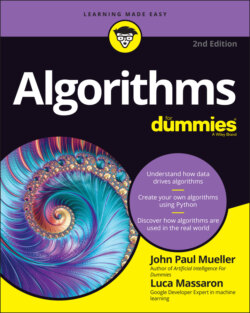Читать книгу Algorithms For Dummies - John Paul Mueller, John Mueller Paul, Luca Massaron - Страница 14
Using Computers to Solve Problems
ОглавлениеThe term computer sounds quite technical and possibly a bit overwhelming to some people, but people today are neck deep (possibly even deeper) in computers. You wear at least one computer, your smartphone, most of the time. If you have any sort of special device, such as a pacemaker, it also includes a computer. A car can contain as many as 150 computers in the form of embedded microprocessors that regulate fuel consumption, engine combustion, transmission, steering, and stability (see https://spectrum.ieee.org/software-eating-car for details), provide Advanced Driver-Assist Systems (ADAS), and more lines of code than a jet fighter. A computer exists to solve problems quickly and with less effort than solving them manually. Consequently, it shouldn’t surprise you that this book uses still more computers to help you understand algorithms better.
Computers vary in a number of ways. The computer in a watch is quite small; the one on a desktop quite large. Supercomputers are immense and contain many smaller computers all tasked to work together to solve complex issues, such as predicting tomorrow’s weather. The most complex algorithms rely on special computer functionality to obtain solutions to the issues people design them to solve. Yes, you could use lesser resources to perform the task, but the trade-off is waiting a lot longer for an answer, or getting an answer that lacks sufficient accuracy to provide a useful solution. In some cases, you wait so long that the answer is no longer important. With the need for both speed and accuracy in mind, the following sections discuss some special computer features that can affect algorithms.
